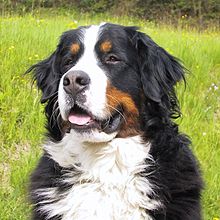Malignant histiocytosis

The malignant histiocytosis or Histiocytic sarcoma is a cancer of the dog that especially when Bernese mountain dog occurs and at this race as a genetic disease one of the most common causes of death represents. The disease is rare in other dog breeds. Malignant histiocytosis can appear as a skin form ("cutaneous histiocytosis") or as a generalized form ("disseminated histiocytosis").
Pathophysiology
Histiocytes are cells that occur especially in connective tissue and belong to the macrophages and perform certain functions of the immune system in the tissue . Through mutation , these cells can degenerate into malignant cells and thus form a tumor that has a pronounced tendency to metastasize . These metastases destroy vital organs through their uncontrolled and invasive growth, which ultimately leads to the death of the dog.
clinic
Signal element
Malignant histiocytosis typically develops in young to middle-aged dogs between the ages of two and eight years. Males are more often affected than bitches. The vast majority of cases occur in the Bernese Mountain Dog. In principle, sporadic cases can occur in all breeds, although a certain frequency has been described in Flat Coated Retrievers , Golden Retrievers , Irish Wolfhounds and Rottweilers .
Symptoms
Dogs affected by the skin shape show lumps and plaque formation in the skin - especially on the scrotum in males - as well as the nasal and eye mucous membranes. The lesions are poorly demarcated, sometimes accompanied by alopecia , and can ulcerate . They develop in flares and can slowly regress after a flare, only to reappear after a few months. The disease usually gets worse with each new attack. The lesions can spread to other organs as well, especially lymph nodes , spleen, and bone marrow .
Disseminated malignant histiocytosis usually proceeds without skin involvement. The lungs , lymph nodes, and liver are most commonly affected . Affected dogs show weakness, loss of appetite, fatigue, weight loss, and difficulty breathing; less often problems swallowing or coughing. The tumors appear as large, single, solid masses that destroy the affected organs through their invasive growth. The disseminated form does not run in episodes, but rather rapidly progressive and in the vast majority of cases leads to death in less than six months.
diagnosis
A suspicion of cutaneous histiocytosis arises from the typical signaling of the dog in connection with the main symptoms. The disseminated histiocytosis often shows up in the X-ray image , where lung metastases and bone metastases in particular can be seen. The diagnosis is confirmed by a microscopic examination of biopsies taken from suspicious tissue.
Therapy and prognosis
There is no satisfactory treatment for malignant histiocytosis. Surgical excision is rarely practical, and the tumors are not very sensitive to radiation and chemotherapy . Treatment is therefore palliative in most cases . Bovine Thymosin 5 has shown limited success in treating the skin shape. The life expectancy after diagnosis is a few months, only a few dogs survive longer than six months.
Genetics and Breeding Hygiene
Malignant histiocytosis in the Bernese Mountain Dog follows a polygenic inheritance . Various breed clubs have introduced a breeding value assessment for this breed to combat the disease .
Web links
- Page about histiocytosis in dogs of UC Davis
- Malignant Histiocytosis on the UPEI website
- Necropsy of a dog who died of malignant histiocytosis: heart and lungs , kidney
Individual evidence
- ↑ a b c d Tumors with Histiocytic Differentiation. In: The Merck Veterinary Manual. 9th edition. Whitehouse Station, NJ, USA 2005, ISBN 0-911910-50-6 , pp. 786 f.
- ↑ E. Vögeli et al.: The histiocytic sarcoma in the Bernese Mountain Dog in Switzerland (PDF; 651 kB). In: dogs. 13/2006.